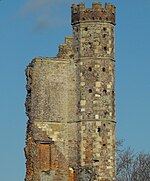St Thomas à Becket Church, sometimes referred to as St Thomas of Canterbury's Church and known until 1796 as the Church of Our Lady, is the Church of England parish church of Warblington in Hampshire, England. It was founded in the Saxon era, and some Anglo-Saxon architecture survives. Otherwise the church is largely of 12th- and 13th-century appearance; minimal restoration work was undertaken in the 19th century. Its situation in a "lonely but well-filled churchyard" in a rural setting next to a farm made it a common site for body snatching in that era, and two huts built for grave-watchers survive at opposite corners of the churchyard.
Warblington is now a suburban area within the South Hampshire conurbation, and the church is about 1 mile (1.6 km) from the centre of Havant, the nearest large town, but St Thomas à Becket Church stands in a secluded area between a major trunk road and an inlet of the English Channel. Until the 19th century, when the parish was subdivided, the church served a large area including the nearby town of Emsworth. The parishes of Warblington and Emsworth have now been reunited, and regular services are held both at Warblington and at St James's Church in Emsworth.
The church is Grade I listed, the highest grade, for its architectural and historical importance. Listed separately at Grade II, the lowest grade, are the two grave-watchers' huts in the churchyard, which also has an "especially good group of mid-18th-century headstones". Important fittings in the church include a range of medieval and later monuments and locally made 13th-century encaustic tiles.










